This set of Corrosion Engineering Multiple Choice Questions & Answers (MCQs) focuses on “Corrosion Principles – Effect of Oxygen and Velocity”.
1. What is the nature of region number 1 in the given figure?
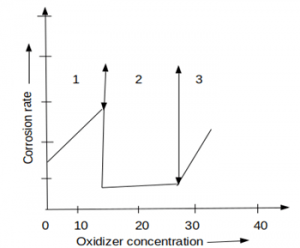
a) Active region
b) Passive region
c) Trans passive region
d) Active-Passive transition region
View Answer
Explanation: The active region is the region in which the corrosion rate increases with an increase in oxidizer concentration. Iron in oxygenated water is the best example of an active region. Because iron will not undergo the transition to passive region irrespective of the concentration of oxygen present at room temperature.
2. What is the nature of region number 2 described in the given figure?
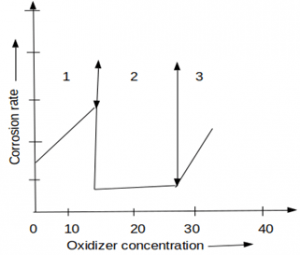
a) Active region
b) Passive region
c) Trans passive region
d) Active-Passive transition region
View Answer
Explanation: The passive region is the region in which the corrosion rate is very less and even become independent with the concentration of oxygen. Hastelloy C in FeCl3 solution is the best example of a passive state region.
3. What is the nature of region number 3 in the given figure?
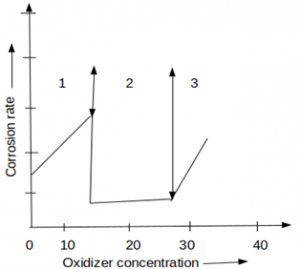
a) Active region
b) Passive region
c) Trans passive region
d) Active-Passive transition region
View Answer
Explanation: Trans passive transition is obtained from passive state due to the presence of a high concentration of oxidizers. This transition initiated with the breakage of protective films and it increases exponentially with the increase in oxidizer concentration.
4. Passivity is achieved only if a sufficient quantity of oxidizer is added to the medium.
a) True
b) False
View Answer
Explanation: In practical cases, the corrosion rate is estimated based on the current density generated. We know that the current density increases with the increase in oxidizer concentration and passivity will only be achieved when the current density crosses critical current density value (ic).
5. Which of the following metal-acid combination will shift metal from active to passive state with an increase in oxidizer concentration?
a) Monel in HCl+O2
b) 18Cr-8Ni in H2SO4+Fe+3
c) Fe in H2O+O2
d) 18Cr-8Ni in HNO3 + Cr2O3
View Answer
Explanation: Initially corrosion rate of Stainless steel (18Cr – 8Ni) in sulfuric acid increases with an increase in the concentration of ferric ion (Fe+3). And then it is followed by a rapid decrease in corrosion rate due to the formation of a passive layer. Critical current density (ic) must be achieved to undergo the transition from active to passive.
6. What is the nature of copper corrosion in oxygenated sulfuric acid?
a) Active region
b) Passive region
c) Active-Passive transition region
d) Trans-passive region
View Answer
Explanation: Copper will act as an active metal in sulfuric acid, the corrosion rate increases with an increase in oxygen concentration. And the passivity is not achieved irrespective of the oxidizer added.
7. The corrosion rate depends on both the medium and the metal involved.
a) True
b) False
View Answer
Explanation: We know that different metals will respond differently in the same medium. In another case, the same metal shows different characters in different mediums. Thus, the corrosion rate depends on both the medium and the metal involved in the reaction.
8. What is the other name of concentration polarization?
a) Anodic diffusion control
b) Cathodic diffusion control
c) Erosion corrosion
d) Activation polarization
View Answer
Explanation: Concentration polarization is also called as cathodic diffusion control. Concentration polarization is controlled by the diffusion of ions from the bulk solution to the metal electrolyte interface. This diffusion can be accelerated by agitation or by increasing the velocity of the solution.
9. Which of the following metals are more corrosion resistant in a high-velocity corrosive solution?
a) Stainless steel
b) Lead
c) Titanium
d) Both stainless steel and titanium
View Answer
Explanation: Stainless steel and titanium are easily passivating material and easily get passivated in high-velocity mediums. These metals form a stable oxide layer that can resist high velocities of corrosive medium.
10. Which of the following corrosion is indicated by the C curve in the given figure?
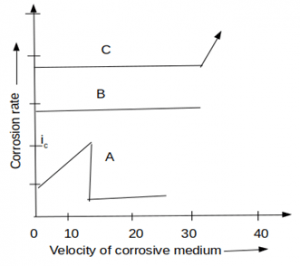
a) Uniform corrosion
b) Galvanic corrosion
c) Erosion corrosion
d) Stress cracking corrosion
View Answer
Explanation: Erosion corrosion is the mechanical damage of the material due to the high velocity of the medium. The effect of agitation or velocity will have a negligible effect until the mechanical damage initiates.
11. Which of the following reaction is depicted by curve A in the given figure?
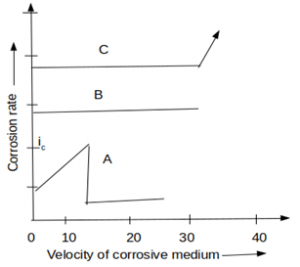
a) Fe in dilute HCl
b) Pb in dilute H2SO4
c) 18Cr–8Ni in H2SO4
d) 18Cr–8Ni in H2SO4+Fe+3
View Answer
Explanation: Stainless steel in H2SO4 with the impurity of ferric ions (Fe+3) follows curve A. Initially, the corrosion rate of stainless-steel increases with the increase in velocity up to critical current density (ic). Then the corrosion rate of stainless-steel decreases rapidly and becomes almost constant due to passivation.
Sanfoundry Global Education & Learning Series – Corrosion Engineering.
To practice all areas of Corrosion Engineering, here is complete set of 1000+ Multiple Choice Questions and Answers.
If you find a mistake in question / option / answer, kindly take a screenshot and email to [email protected]
- Check Mechanical Engineering Books
- Apply for Metallurgical Engineering Internship
- Check Metallurgical Engineering Books
- Practice Metallurgical Engineering MCQs
- Check Corrosion Engineering Books
